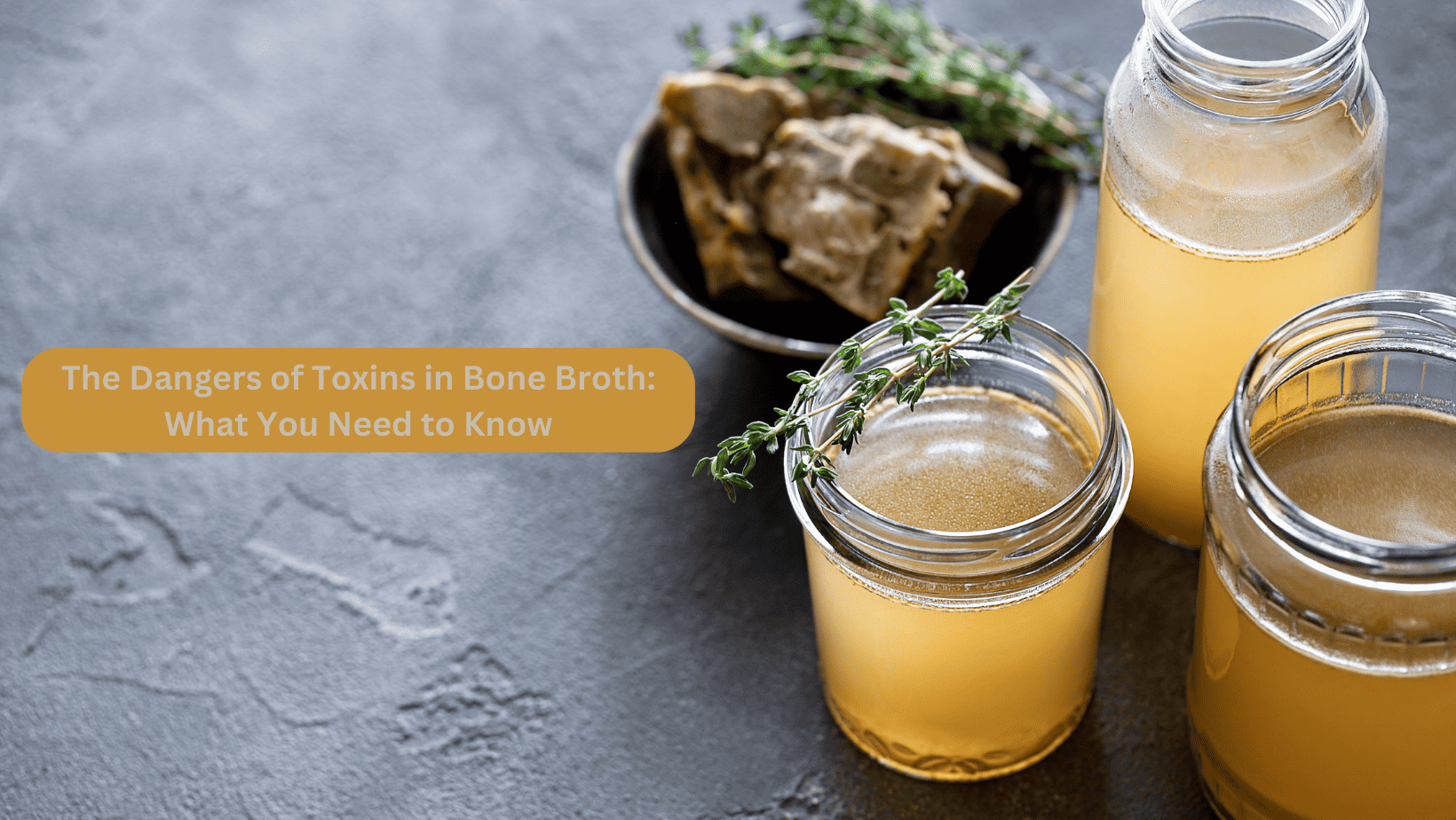The Dangers of Toxins in Bone Broth: What You Need to Know
Bone broth has become a popular health trend in recent years for its numerous potential health benefits, including improving gut health, reducing joint pain and inflammation, and promoting healthy skin and hair. However, many people are unaware of the potential risks associated with consuming bone broth, specifically the presence of toxins and contaminants that may be present in the broth.
If you have been interested in adding the nutrient-rich liquid into your diet, but are hesitant due to potential risks, learn what you need to know below.
Understanding Bone Broth and Its Health Benefits
Despite having potential risks, bone broth offers numerous health benefits, typically made by simmering animal bones (usually beef or chicken) along with vegetables and herbs for an extended period. This process extracts the nutrients and collagen from the bones, resulting in a nutrient-rich broth that can be used as a soup base, added to recipes or simply enjoyed straight.
What is Bone Broth?
Bone broth, as mentioned before, is made by simmering animal bones. It can be made from beef, chicken, fish or any animal that has bones.
Nutritional Components of Bone Broth
Bone broth is rich in nutrients such as amino acids, collagen, gelatin and essential minerals like calcium, magnesium, and potassium. These nutrients can help support the immune system, promote healthy digestion, and improve joint health and skin quality.
Common Health Claims Associated with Bone Broth
Bone broth has been attributed to numerous health claims, including improving gut health, reducing inflammation, promoting weight loss, and supporting overall wellness. While some of these claims may be valid, it’s important to understand that research is limited, and more studies are needed to understand the benefits of bone broth fully.
Despite the limited research, many reasons exist to incorporate bone broth into your diet. These include:
Ant-Inflammation:
The amino acids found in bone broth have been shown to help reduce inflammation in the body, which can help with conditions such as arthritis and other inflammatory diseases.
Collagen Boost:
Bone broth is also a great source of collagen, which is important for maintaining healthy skin, hair, and nails.
Gut Health:
In terms of gut health, bone broth contains gelatin, which can help to soothe and heal the lining of the gut. This can be particularly beneficial for those with conditions such as leaky gut syndrome or irritable bowel syndrome (IBS).
Detoxification:
Another potential benefit of bone broth is that it can support the liver’s detoxification processes. The amino acids and minerals found in bone broth are important for liver function and can help to support the body’s natural detoxification processes.
It’s worth noting that not all bone broths are created equal. Choosing high-quality bones from healthy animals and using organic vegetables and herbs whenever possible is important. Some bone broths may contain added salt or other ingredients, so it’s important to read the label carefully.
Toxins and Contaminants in Bone Broth
While consuming bone broth may have potential health benefits, it’s important to be aware of potential toxins and contaminants that may be present in the broth. Bone broth has gained popularity in recent years as a health food, with claims that it can improve gut health, boost the immune system, and even reduce joint pain. However, it is crucial to know what you’re consuming and where it comes from.
Heavy Metals
Heavy metals such as lead, cadmium, and mercury can be present in bone broth, particularly if the bones come from animals raised in polluted areas or areas with heavy metal contamination. These metals can accumulate in the bones and be released into the broth during cooking. It’s important to source bones from reputable suppliers who can verify that the animals were raised in clean and safe environments.
Bacteria and Pathogens
Bone broth can also be a breeding ground for harmful bacteria if it is not prepared and stored properly. Bacteria such as E.coli and salmonella can cause serious illness if ingested. Following proper food safety guidelines when preparing and storing bone broth is important.
When making bone broth, it’s important to cook it at a high enough temperature for a long enough time to kill any bacteria that may be present. It’s also important to store the broth in the refrigerator or freezer to prevent any bacteria from growing.
Pesticides and Antibiotics
Animals that are raised conventionally may have been treated with antibiotics and pesticides, which can accumulate in their bones. These chemicals can be released into the broth during the cooking process. It’s important to source bones from animals that were raised without the use of antibiotics and pesticides.
Organic and grass-fed animals are generally considered to be safer options when it comes to bone broth. These animals are not treated with antibiotics or pesticides and are typically raised in more natural and sustainable environments.
Environmental Pollutants
Bone broth may also contain environmental pollutants such as dioxins and PCBs found in air, water, and soil and can accumulate in animal tissues. These pollutants can also be released into the broth during the cooking process. It’s important to source bones from animals that were raised in clean and safe environments.
One way to reduce your exposure to environmental pollutants in bone broth is to make it with a variety of bones from different animals. This can help to dilute any potential contaminants that may be present in a single type of bone.
Bone broth can be a nutritious and beneficial addition to your diet, but it’s important to be aware of potential toxins and contaminants that may be present. By sourcing bones from reputable suppliers and following proper food safety guidelines, you can enjoy the health benefits of bone broth while minimizing your exposure to harmful substances.
Factors Contributing to Toxin Levels in Bone Broth
The level of toxins and contaminants in bone broth can vary based on several factors. It’s important to be aware of these factors when choosing to consume bone broth regularly.
Source of Bones
The source of the bones used to make bone broth is a crucial factor in determining its safety. Bones from healthy and pasture-raised animals that have not been exposed to toxins or pollutants are the best option. These animals are typically fed a natural diet free from antibiotics and growth hormones, which can accumulate in their bones and be released into the broth during cooking. Consuming bone broth made from conventionally-raised animals increases the risk of consuming harmful chemicals and toxins.
When choosing bones for your broth, look for those that are labeled as grass-fed, pasture-raised, or organic. These labels indicate that the animals were raised in a healthy and humane environment, which is better for the animals and the quality and safety of the food they produce.
Cooking Methods and Duration
The cooking method and duration are also important factors to consider when making bone broth. The longer the bones are simmered, the higher the risk of heavy metals and other contaminants being released into the broth. It’s important to use safe cooking methods and keep cooking time to a minimum, typically around 12 to 24 hours.
One safe method for making bone broth is to use a slow cooker or crockpot. This method allows the broth to cook at a low and consistent temperature, which reduces the risk of contaminants being released into the broth. Another safe method is to use a pressure cooker, which can reduce cooking time and minimize the release of toxins.
It’s also important to skim any foam or impurities that rise to the surface of the broth during cooking. This will help to remove any impurities that may have been released from the bones.
Storage and Preservation Techniques
Proper storage and preservation of bone broth are crucial to prevent the growth of harmful bacteria and ensure its safety for consumption. Bone broth should be stored in airtight containers in the fridge or freezer to prevent contamination.
It’s important to consume the broth within a few days of making it or freeze it for longer storage. When reheating bone broth, it’s important to bring it to a boil to ensure that any bacteria that may have grown during storage are killed.
Another way to preserve bone broth is to can it using a pressure canner. This method involves heating the broth to a high temperature, which kills any bacteria and allows it to be stored at room temperature for long periods.
Overall, bone broth can be a nutritious and delicious addition to your diet, but it’s important to be aware of the factors that can affect its safety and quality. By choosing bones from healthy animals, using safe cooking methods, and properly storing and preserving the broth, you can enjoy the benefits of this traditional food without any worries.
How to Choose Safe and High-Quality Bone Broth
If you consume bone broth, it’s important to choose safe and high-quality broth to reduce exposure to toxins and contaminants. Bone broth has become increasingly popular in recent years due to its many health benefits. It is rich in nutrients like collagen, gelatin, and amino acids, which are essential for maintaining healthy skin, hair, joints, and gut health.
Opt for Organic and Grass-Fed Ingredients
When choosing bone broth, looking for organic and grass-fed ingredients is important. Animals that are raised on organic farms and fed grass have lower levels of toxins, pesticides, and antibiotics in their system. This means that the resulting broth is safer and healthier for consumption.
Organic farming practices also help protect the environment by reducing harmful chemicals and promoting sustainable agriculture. Grass-fed animals are also less likely to be exposed to harmful chemicals and are generally healthier than conventionally raised animals.
Look for Transparent Sourcing and Production Practices
Another important factor to consider when choosing bone broth is the transparency of the sourcing and production practices. It’s important to choose companies that are open and honest about where they source their ingredients, how they prepare the broth and any third-party testing, they have conducted to ensure safety and quality.
Companies that prioritize transparency are more likely to have high-quality products and are committed to providing their customers with safe and healthy bone broth. They are also more likely to be environmentally conscious and socially responsible.
Consider Homemade Bone Broth
One of the best ways to ensure that you are consuming safe and high-quality bone broth is to make it at home. This gives you complete control over the ingredients and cooking methods. You can choose high-quality, pasture-raised bones and follow safe cooking methods to reduce your exposure to toxins and contaminants.
Making bone broth at home is also more cost-effective than buying pre-made broth. You can use leftover bones from meals or purchase bones from a local farm or butcher. Homemade bone broth can also be customized to your taste preferences by adding herbs, spices, and vegetables.
Choosing safe and high-quality bone broth is important for reaping the many health benefits of this nutrient-rich food. Opt for organic and grass-fed ingredients, look for transparent sourcing and production practices, and consider making bone broth at home for the safest and healthiest option.
Final Thoughts
While bone broth has gained popularity as a health food in recent years, it’s important to be aware of the potential risks associated with consuming it. The presence of toxins and contaminants in bone broth can harm your health, and it’s important to choose safe and high-quality products or make them at home. By being aware of these risks and taking steps to reduce exposure, you can safely enjoy the potential health benefits of bone broth without compromising your health.
Organixx Clean Sourced Collagens blend contains five types of collagen from four sources. What’s more, it’s combined with targeted nutrients such as zinc, vitamin C, and vitamin B6 which specifically enhance the bioavailability and potency of collagen. Clean Sourced Collagens is formulated from the ground up to enhance and support your body’s natural ability to heal and rebuild itself from the INSIDE out.





Comments